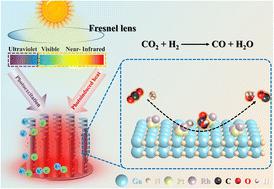当前位置:
X-MOL 学术
›
Chem. Sci.
›
论文详情
Our official English website, www.x-mol.net, welcomes your feedback! (Note: you will need to create a separate account there.)
Photo-thermal synergistic CO2 hydrogenation towards CO over PtRh bimetal-decorated GaN nanowires/Si
Chemical Science ( IF 8.4 ) Pub Date : 2024-04-23 , DOI: 10.1039/d4sc01530d Jinglin Li 1 , Bowen Sheng 2 , Liang Qiu 1 , Jiajia Yang 2 , Ping Wang 2 , Yixin Li 1 , Tianqi Yu 1 , Hu Pan 1 , Ying Li 1 , Muhan Li 1 , Lei Zhu 1 , Xinqiang Wang 2, 3, 4 , Zhen Huang 1 , Baowen Zhou 1
Chemical Science ( IF 8.4 ) Pub Date : 2024-04-23 , DOI: 10.1039/d4sc01530d Jinglin Li 1 , Bowen Sheng 2 , Liang Qiu 1 , Jiajia Yang 2 , Ping Wang 2 , Yixin Li 1 , Tianqi Yu 1 , Hu Pan 1 , Ying Li 1 , Muhan Li 1 , Lei Zhu 1 , Xinqiang Wang 2, 3, 4 , Zhen Huang 1 , Baowen Zhou 1
Affiliation

|
Photo-thermal-synergistic hydrogenation is a promising strategy for upcycling carbon dioxide into fuels and chemicals by maximally utilizing full-spectrum solar energy. Herein, by immobilizing Pt–Rh bimetal onto a well-developed GaN NWs/Si platform, CO2 was photo-thermo-catalytically hydrogenated towards CO under concentrated light illumination without extra energies. The as-designed architecture demonstrates a considerable CO evolution rate of 11.7 mol gGaN−1 h−1 with a high selectivity of 98.5% under concentrated light illumination of 5.3 W cm−2, leading to a benchmark turnover frequency of 26 486 mol CO per mol PtRh per hour. It is nearly 2–3 orders of magnitude higher than that of pure thermal catalysis under the same temperature by external heating without light. Control experiments, various spectroscopic characterization methods, and density functional theory calculations are correlatively conducted to reveal the origin of the remarkable performance as well as the photo-thermal enhanced mechanism. It is found that the recombination of photogenerated electron–hole pairs is dramatically inhibited under high temperatures arising from the photothermal effect. More critically, the synergy between photogenerated carriers arising from ultraviolet light and photoinduced heat arising from visible- and infrared light enables a sharp reduction of the apparent activation barrier of CO2 hydrogenation from 2.09 downward to 1.18 eV. The evolution pathway of CO2 hydrogenation towards CO is also disclosed at the molecular level. Furthermore, compared to monometallic Pt, the introduction of Rh further reduces the desorption energy barrier of *CO by optimizing the electronic properties of Pt, thus enabling the achievement of excellent activity and selectivity. This work provides new insights into CO2 hydrogenation by maximally utilizing full-spectrum sunlight via photo-thermal synergy.
中文翻译:

PtRh 双金属修饰的 GaN 纳米线/Si 上光热协同 CO2 加氢生成 CO
光热协同氢化是一种通过最大限度地利用全光谱太阳能将二氧化碳升级回收为燃料和化学品的有前景的策略。在此,通过将Pt-Rh双金属固定在成熟的GaN NWs/Si平台上,CO 2在集中光照射下无需额外能量即可光热催化氢化为CO。所设计的架构在 5.3 W cm -2的集中光照射下表现出 11.7 mol g GaN −1 h −1的相当大的 CO 演化速率和 98.5% 的高选择性,导致基准周转频率为 26 486 mol CO每摩尔 PtRh 每小时。在相同温度下,无需光照而外部加热,比纯热催化提高了近2-3个数量级。通过控制实验、各种光谱表征方法和密度泛函理论计算,揭示了其卓越性能的起源以及光热增强机制。研究发现,在光热效应产生的高温下,光生电子-空穴对的复合受到显着抑制。更关键的是,紫外光产生的光生载流子与可见光和红外光产生的光生热之间的协同作用使得CO 2加氢的表观活化能垒从2.09 eV急剧降低至1.18 eV。还公开了分子水平上CO 2加氢生成CO的演化途径。此外,与单金属Pt相比,Rh的引入通过优化Pt的电子特性进一步降低了*CO的解吸能垒,从而实现了优异的活性和选择性。这项工作通过光热协同作用最大限度地利用全光谱太阳光,为CO 2加氢提供了新的见解。
更新日期:2024-04-23
中文翻译:

PtRh 双金属修饰的 GaN 纳米线/Si 上光热协同 CO2 加氢生成 CO
光热协同氢化是一种通过最大限度地利用全光谱太阳能将二氧化碳升级回收为燃料和化学品的有前景的策略。在此,通过将Pt-Rh双金属固定在成熟的GaN NWs/Si平台上,CO 2在集中光照射下无需额外能量即可光热催化氢化为CO。所设计的架构在 5.3 W cm -2的集中光照射下表现出 11.7 mol g GaN −1 h −1的相当大的 CO 演化速率和 98.5% 的高选择性,导致基准周转频率为 26 486 mol CO每摩尔 PtRh 每小时。在相同温度下,无需光照而外部加热,比纯热催化提高了近2-3个数量级。通过控制实验、各种光谱表征方法和密度泛函理论计算,揭示了其卓越性能的起源以及光热增强机制。研究发现,在光热效应产生的高温下,光生电子-空穴对的复合受到显着抑制。更关键的是,紫外光产生的光生载流子与可见光和红外光产生的光生热之间的协同作用使得CO 2加氢的表观活化能垒从2.09 eV急剧降低至1.18 eV。还公开了分子水平上CO 2加氢生成CO的演化途径。此外,与单金属Pt相比,Rh的引入通过优化Pt的电子特性进一步降低了*CO的解吸能垒,从而实现了优异的活性和选择性。这项工作通过光热协同作用最大限度地利用全光谱太阳光,为CO 2加氢提供了新的见解。



























 京公网安备 11010802027423号
京公网安备 11010802027423号